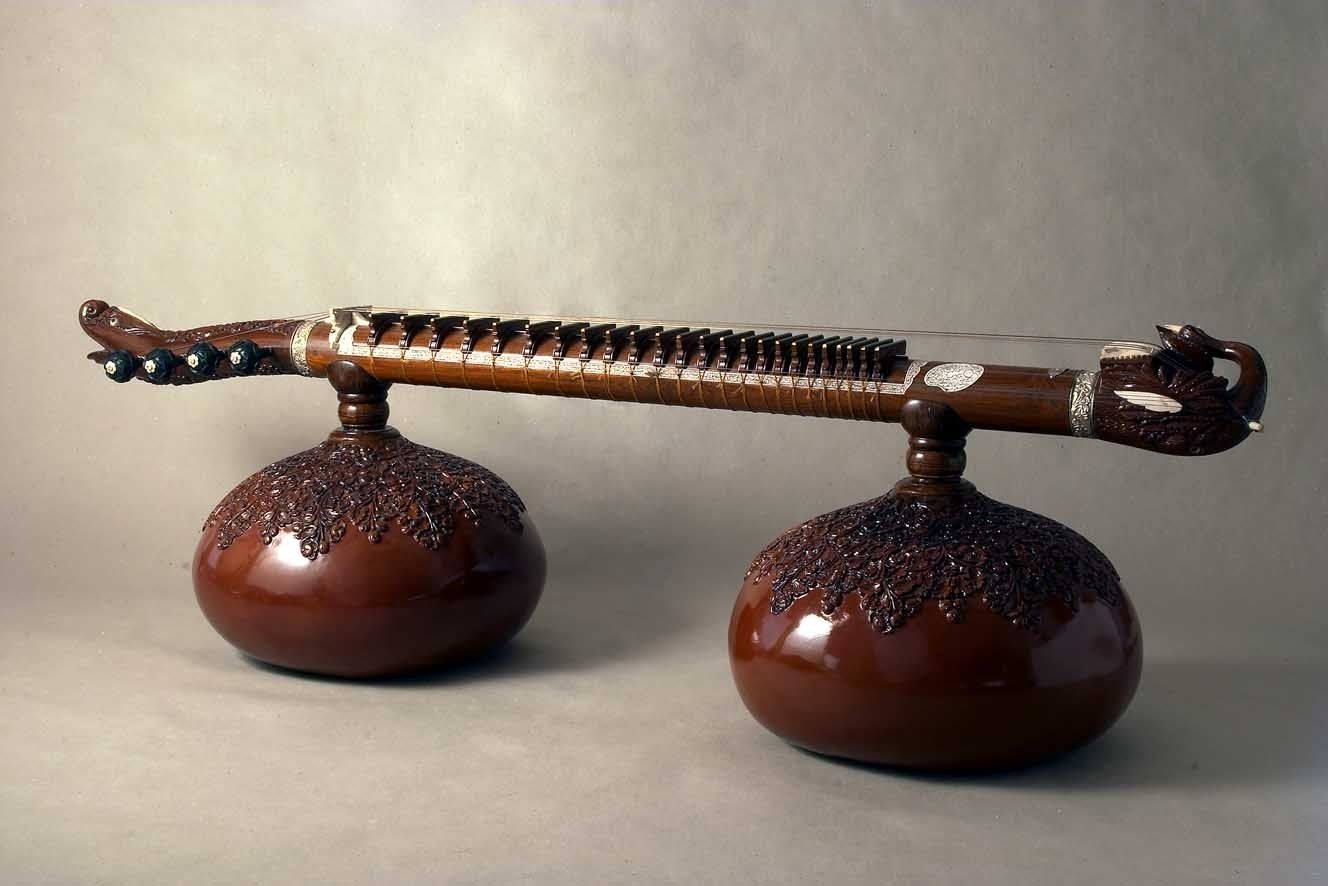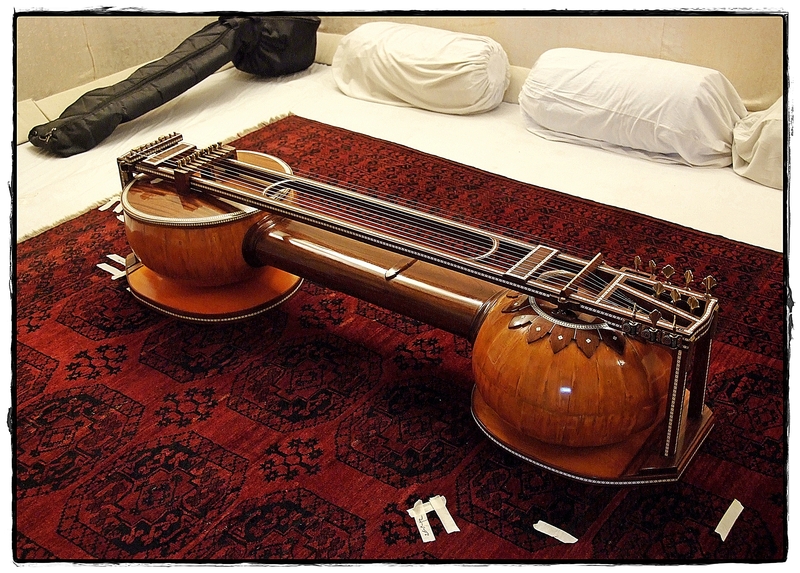Maa Saraswathi And Queen Of Instruments September 16, 2022 – Posted in: Blog
Maa Saraswati, the Hindu goddess of wisdom, is also revered as the empress of the arts, music, and sciences. She is Lord Brahma’s partner and the secret to all formulations used worldwide. She is Lord Ganesha’s sister and Maa Durga’s daughter. Along with Goddess Kali and Devi Laxmi, she plays a crucial part in maintaining all earthly occurrences. She is a vital source of energy and intelligence.
As the deity who ensures that Gautama Buddha’s teachings are put into practice, Goddess Saraswati plays a crucial role in Buddhism. The lotus that Devi Saraswati is seated on is revered as a symbol of ultimate enlightenment.
The Veena Saraswati Maa holding represents wisdom and insight in addition to music.
Essentially, Saraswati has been hailed as the Goddess of knowledge and consciousness due to her creative prowess and function as Vak, indicating her link with the Supreme being and hence the genuine consciousness. She has a more prominent modern presence and receives more acclaim than Brahma as the Goddess Saraswati.
MAA SARASWATI’S SYMBOLISM: GODDESS OF KNOWLEDGE
Peacock and Saraswati Mata: The peacock is symbolic of conceit and satisfaction with one’s supremacy. The Goddess teaches us to focus on the eternal truth rather than on external features by using a peacock as her mount.
Lotus: Saraswati is fundamentally associated with the colour white, which connotes the purity of wisdom. Saraswati Mata wears white. She typically depicts herself sitting on a white lotus and carrying a white sari. She is the personification of unadulterated knowledge, according to White Sari.
Veena: Veena is a string instrument that requires a musical mind and exceptional control. Veena’s playing conveys the message that people should balance their spirits and abilities in order to live in harmony with the rest of the world and have a deeper understanding of life. Veena signifies controllable, experiential music, and it also reveals Saraswati as the goddess of art, craft, and technology.
Swan: Swan represents the ability to discriminate between what is important and what is unimportant, as well as between what is right and wrong. A swan’s ability to remain in the water and swim without being influenced by the waves is another crucial quality. This clarifies how to apply information with discernment and float above life’s currents so that you can glimpse the Divine Spirit without being impacted.
Four Arms: Saraswati Mata is extremely attractive and is seen holding several significant artefacts in her four arms. The four hands also represent the four facets of the inner self: the manas (mind), buddha (intellect), Chitta (pure consciousness), and ego (ahamkara).
__________________________________________________________________________________________________________________________________________________
Also Read : Lighten Your Wardrobe With The Bar Pendants
__________________________________________________________________________________________________________________________________________________
SARSAWATHI VEENA AND ITS SIGNIFICANCE
Veena is an Indian string instrument that dates back to around 1700 BCE. They were inspired by the twanging sound made by archer’s bows, known musically as “jya ghosha” in the ancient Atharvaveda and called “vil yazh” in Tamil. Veenas were initially used to refer to any stringed instrument, but throughout time, more particular definitions were developed. A plucked instrument called a Saraswati veena, for instance, was named after the Hindu goddess Saraswati. It is also known as the “tanjauri veena,” and it is still regarded as one of the most significant musical instruments in southern India.
The Hindu goddess Saraswati is revered as the embodiment of wisdom and language. The Vedas, the historic Hindu texts, are considered to have her as their mother. The Saraswati veena is named after her because it is said to be her instrument of choice, and she is often shown to be playing the instrument while sitting upon a swan.
The goddess of learning, Saraswati, is holding the most advanced string instrument ever created by modern musicians. Veena is held by Saraswati with her right hand on the lower side and her left hand on the upper side, signifying that she has complete control over the power of knowledge and education for her followers. Veena music is often used to represent the first sound of creation.
TYPES OF VEENA
Rudra veena: One of the biggest string instruments in Indian classical music is the Rudra Veena. It is also one of the oldest musical instruments to be used in classical music. According to mythology, Lord Shiva from the Hindu triad served as a major inspiration. The instrument has a healing connection with the listener and represents Indian spiritual culture throughout the subcontinent. Being the only rich acoustic string instrument, it is described as the mother of all string instruments. Furthermore, regarding its sound, it possesses the power to purify both the mind of the musician and the listeners.
Sagra Veena: A contemporary variation of the current selection of string instruments is the Sagar Veena. It belongs to the North Indian Classical Music subgenre and has ties to Pakistani music.
The Sagar Veena was created in 1970 by Pakistani attorney Raza Kazim. Since then, both its structure and tone have changed from those of other instruments. His daughter Noor Zehra continues to be the only Sagar Veena player throughout this time. She effectively made a name for herself in Pakistan and has performed both inside and beyond the nation. Filled with a deep and reverberating sound, it supplies the overall quality of sound with clarity.
Focusing on the purpose of sound, the instrument has the ability to soulfully interact with the listeners. It also develops their internal processes of thoughts, emotions and sensitivities.
Sarangi: A significant Veena-like instrument with a long history, the Sarangi dates back to about 5000 BC. In Hindustani music, especially in the 17th century, it is highly common.
The Hindi word “Sau Rang,” which translates to “one hundred colours,” is where the name “Sarangi” also comes from. The phrase “one hundred colours” suggests that the instrument can accommodate a variety of vocal melodies. It was meant to suggest that it is capable of a wide range of tonal colours and emotional gradations.
Saraswathi veena: The Hindu goddess Saraswati is the source of the name of the veena instrument. Saraswati is either holding or playing the instrument, drawing inspiration from the Hindu faith.
This specific Veena has a lengthy history that dates back to roughly 1500 BC. The Saraswati Veena’s characteristic tone is powerful and steely, yet graceful and warm.
This instrument can be used to play the melodic and rhythmic intricacies of Indian raga music. It is a melodic instrument that is enticing yet difficult to adapt to other musical styles.
Sarod: A well-known string instrument is a sarod (Saradiya Veena). It is typical of the Hindustani music subgenre and is well-liked in Bangladesh, Pakistan, and Northern India.
The Sarod was in use in its present form during the 19th century. A traditional Sarod has a sturdy wooden body with a skin belly that is around 100 cm (39 inches) long. A modern Sarod, however, contains 4-6 major melody strings. It features sympathetic and drone strings to emphasise its real sound, just as other Veena instruments.
Sitar: The Sitar is a tall, slender Indian lute that is played with a wire pick and has movable frets. The best Sitars of the twenty-first century are made of teak and mahogany. In nations like Bangladesh, Pakistan, and Northern India, the instrument is particularly well-liked.
The 16th and 17th centuries saw the Sitar’s greatest periods of development historically. It has gained notoriety and is well-known in South Asian music of the twenty-first century.
Along with the tambura and the tabla, it is useful as a solo instrument in Hindustani music, where it is becoming prevalent. Its distinctive sound is produced by the vibrating string on a flat bridge with a softly curved surface as it relates to the listener’s ears.
Vichitra veena: A string instrument primarily utilised in Hindustani music is the vichitra veena. Additionally, it came into the public eye around the start of the 20th century.
However, due to the instrument’s age, it is challenging to play melodic notes. The left-hand holds a round glass piece while delicately gliding it across the strings in an attempt to create music. Thus, it is tricky to play a fast rhythm song on the Vichitra Veena. A rich and lovely sound is created when musical portions are played at a steady tempo, though. It has a tune that is similar to the sound of a person humming.
_________________________________________________________________________________________________________________________________________________
Also Read : Feel The Love With The Stroke Of Creativity | Name Pendants
__________________________________________________________________________________________________________________________________________________
WHICH GOD OWNS EACH COMPONENT OF THE VEENA?
Many artists also hold the belief that the entire veena is one Hindu God who resides in all of its parts. As a result, the Veena is not just a divine instrument but also a place where many Hindu gods and goddesses live. For instance, when the strings are being hommed to Parvati, Shiva remains in the instrument’s neck. Additionally, additional deities including Lord Brahma, Lord Vishnu, Goddess Lakshmi, and Goddess Sarasvati also have residences within various areas of the veena.
THE HISTORY OF SARASWATI PUJA
One of the most fortunate days of the year is the day of Basant Panchami. Numerous significant occasions, including weddings, housewarming celebrations, and other auspicious occasions, are held on this day in honour of the goddess Saraswati. The Vedas claim that Saraswati stands for “Ananda,” a surge of love, pleasure, and beauty. According to legend, Goddess Saraswati celebrates her birthday on the day of Basant Panchami. Hindu mythology states that Saraswati, the goddess, was born on this day. The birth of the goddess is commemorated as Basant Panchami in Hindu mythology. According to a different tale, she bestowed culture and wisdom on the renowned poet Kalidasa, inspiring other believers to revere her so she would bestow gifts of knowledge and wisdom upon them, too.
The image of Goddess Saraswati on the idol is shown holding a veena while sitting on a white lotus and wearing white clothing and jewellery. Her hands represent the mind, intellect, attentiveness, and ego, the four facets of nature.
 As the companion of the creator Lord Brahma, the goddess represents the feminine principle of formation as well as the feminine principle of art and music in their purest form, free from manipulation or fear. Given the present jewellery trend, pendants are being updated from every angle. The days of paying outrageous prices for gold or diamond pendants are long gone. Modern millennials who are wise choose magnificent gold pendant sets that precisely match their style and price range.
As the companion of the creator Lord Brahma, the goddess represents the feminine principle of formation as well as the feminine principle of art and music in their purest form, free from manipulation or fear. Given the present jewellery trend, pendants are being updated from every angle. The days of paying outrageous prices for gold or diamond pendants are long gone. Modern millennials who are wise choose magnificent gold pendant sets that precisely match their style and price range.
You can choose from a variety of customized gold pendants without saying that a little pendant can significantly alter your daily appearance.
AuGrav (Au-Gold, Grav-To Etch, to Engrave) Strongly believes that any Jewel should be a natural extension of yourself. It could be as simple as your Names, your Fingerprints, your Voice Waves, or anything that describes your Persona. To create a piece that will be worn by only 1 out of 7 billion people on earth, Get In Touch with us. Our Jewelry experts have all ears to listen to your story and suggest creating a masterpiece.
You May Also Like

















